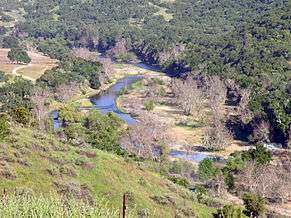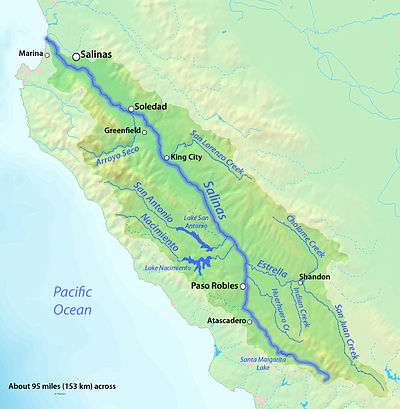Nacimiento River
| Nacimiento River | |
| Rio de las Truchas | |
 The river downstream of Nacimiento Dam | |
| Country | United States |
|---|---|
| State | California |
| Tributaries | |
| - right | Los Burros Creek, Las Tablas Creek |
| Source | Unnamed spring |
| - location | Santa Lucia Mountains, San Luis Obispo County |
| - elevation | 3,280 ft (1,000 m) |
| - coordinates | 36°01′55″N 121°28′21″W / 36.03194°N 121.47250°W [1] |
| Mouth | Salinas River |
| - location | Camp Roberts, Monterey County |
| - elevation | 584 ft (178 m) |
| - coordinates | 35°49′57″N 120°45′30″W / 35.83250°N 120.75833°WCoordinates: 35°49′57″N 120°45′30″W / 35.83250°N 120.75833°W [1] |
| Length | 64.8 mi (104 km) |
| Basin | 350 sq mi (906 km2) |
| Discharge | for below Nacimiento Dam |
| - average | 272 cu ft/s (8 m3/s) [2] |
| - max | 7,340 cu ft/s (208 m3/s) |
| - min | 0 cu ft/s (0 m3/s) |
 Map of the Salinas River watershed including the Nacimiento River | |
The Nacimiento River is a 64.8-mile-long (104.3 km)[3] river in southern Monterey County and northern San Luis Obispo County, California. A large portion of the river's run is on military reservations. The river's upper reaches are inside Fort Hunter Liggett, Lake Nacimiento is in the middle and the lower reaches are inside Camp Roberts. It is the largest tributary of the Salinas River in terms of streamflow.[4]
History
On September 24 and December 17, 1769, the Portolà expedition crossed the river which they named Rio de las Truchas (Spanish for "trout"), saying "We pitched camp on the bank of a small river containing much running water, which, in several pools or eddies, held a considerable number of trout, and other species of fish."[5][6] Nacimiento, meaning "source of the river" in Spanish, was also given to the river by Father Crespi of the Portolà expedition September 21, 1769. Later the river was referred to as Nacimiento by Juan Bautista de Anza who on April 16, 1774, crossed the river and assumed wrongly that Nacimiento had been named for the nativity, also a Spanish translation.[7]
Watershed and Course
The Nacimiento River watershed comprises 361.5 square miles (936 km2).[8] The crest of the Santa Lucia Range forms the southwestern boundary of the Nacimiento River watershed, and the San Antonio River watershed divide forms its northeast boundary. Rising on the east side of the Santa Lucia Mountains, part of the Coast Ranges, the river travels southeast from its headwaters south of Cone Peak, also within the Ventana Wilderness of Los Padres National Forest.[8] Except for its uppermost reaches and headwaters, as well as the short stretch below Nacimiento Dam, much of the river is dry in summer and fall, although perennial pools abound.
After passing through generally hilly terrain, the river is impounded by Nacimiento Dam forms Lake Nacimiento, the largest in San Luis Obispo County. The reservoir is operated by the Monterey County Water Resources Agency and was built in 1957 to provides water for irrigation and groundwater recharge, drought protection, and to provide recreational opportunities such as swimming, boating, fishing and water skiing.[8]
Downstream from the dam, the river travels east until it joins the Salinas River at Camp Roberts, Monterey County. The San Antonio River, which feeds Lake San Antonio and is also a Salinas River tributary, mirrors Nacimiento's path several miles to the northeast.
Tributaries to the upper river include Little Burnett, Tabacco, Salmon, Las Berros, San Miguel, Stony, El Piojo, Waller, and Sapaque Creeks. Streams which flow into the lower river include Las Tablas, Franklin, Town, Dip, Snake, and Kavanaugh creeks. Additional main stem creeks include: Carrals Spring, Slickrock Creek, Stony Creek, San Miguel Creek, Upper Los Berros Creek, N. Fork Los Burros Creek, San Miguelitos Ranch, Gabilan Creek, Los Bueyes Creek, Lower Los Burros Creek, Oak Flat, Waller Creek, Mesa Coyote, Pozo Honda Creek, Turtle Creek and Gulch House Creek.[8]
Ecology
The Cone Peak Gradient Research Natural Area located near the source of the Nacimiento River is an area unusual for its ecological diversity and presence of the rare Santa Lucia fir (Abies bracteata).
Threatened and endangered species in the watershed including the arroyo toad (Bufo californicus), western pond turtle (Actinemys marmorata), California red-legged frog (Rana draytonii) and the California condor (Gymnogyps californianus).[8]
The Nacimiento River historically comprised some of the best steelhead trout (Oncorhynchus mykiss) spawning and rearing habitats in the Salinas River watershed. The Nacimiento Dam was constructed without fish passage and the historic habitats above these dams are no longer available to steelhead.[4][8]
References
- 1 2 "Nacimiento River". Geographic Names Information System. United States Geological Survey. 1981-01-19. Retrieved 2011-05-03.
- ↑ "USGS Gage #11149400 on the Nacimiento River below Nacimiento Dam, near Bradley, CA" (PDF). National Water Information System. U.S. Geological Survey. 1958-present. Retrieved 2011-05-03. Check date values in:
|date=(help) - ↑ U.S. Geological Survey. National Hydrography Dataset high-resolution flowline data. The National Map, accessed March 15, 2011
- 1 2 Gordon S. Becker, Isabelle J. Reining (October 2008). Steelhead/rainbow trout resources of Monterey County in Steelhead/rainbow trout resources south of the Golden Gate, California (PDF) (Report). Oakland, California: Center for Ecosystem Management and Restoration. p. 147. Retrieved 2013-12-01.
- ↑ Miguel Costansó (1769). The Diary of Miguel Costansó, August, 1769 - January, 1770. Retrieved 2013-12-01.
- ↑ Frances Norris Rand Smith (1932). The Mission of San Antonio de Padua. Stanford, California: Stanford University Press. ISBN 9780804717014. Retrieved 2013-12-01.
- ↑ Erwin G. Gudde (1969). 1000 California Place Names. University of California Press. p. 54. Retrieved 2013-12-01.
- 1 2 3 4 5 6 San Antonio and Nacimiento Rivers Watershed Management Plan (PDF) (Report). Monterey County Water Resources Agency. October 2008. Retrieved 2013-12-01.